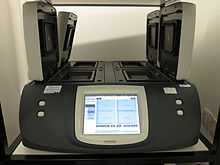Thermal cycler

The thermal cycler (also known as a thermocycler, PCR machine or DNA amplifier) is a laboratory apparatus most commonly used to amplify segments of DNA via the polymerase chain reaction (PCR).[1] Thermal cyclers may also be used in laboratories to facilitate other temperature-sensitive reactions, including but not limited to restriction enzyme digestion or rapid diagnostics.[2] The device has a thermal block with holes where tubes holding the reaction mixtures can be inserted. The cycler then raises and lowers the temperature of the block in discrete, pre-programmed steps.
History
The earliest thermal cyclers were designed for use with the Klenow fragment of DNA polymerase I. Since this enzyme is destroyed during each heating step of the amplification process, new enzyme had to be added every cycle. This led to a cumbersome machine based on an automated pipettor, with open reaction tubes. Later, the PCR process was adapted to the use of thermostable DNA polymerase from Thermus aquaticus, which greatly simplified the design of the thermal cycler. While in some old machines the block is submerged in an oil bath to control temperature, in modern PCR machines a Peltier element is commonly used. Quality thermal cyclers often contain silver blocks to achieve fast temperature changes and uniform temperature throughout the block. Other cyclers have multiple blocks with high heat capacity, each of which is kept at a constant temperature, and the reaction tubes are moved between them by means of an automated process. Minaturized thermal cyclers have been created in which the reaction mixture moves via channel through hot and cold zones on a microfluidic chip. Thermal cyclers designed for quantitative PCR have optical systems which enable fluorescence to be monitored during reaction cycling.
Modern innovations
Modern thermal cyclers are equipped with a heated lid that presses against the lids of the reaction tubes. This prevents condensation of water from the reaction mixtures on the insides of the lids. Traditionally, a layer of mineral oil was used for this purpose.
Some thermal cyclers are equipped with multiple blocks allowing several different PCR reactions to be carried out simultaneously. Some models also have a gradient function to allow for different temperatures in different parts of the block. This is particularly useful when testing suitable annealing temperatures for PCR primers.
Pricing
Thermal cyclers are traditionally very expensive, and typically cost in the thousands of dollars. However, recent developments in open-source hardware designs, at least one of which is commercially available for purchase, have brought the price down significantly.[3]
References
- ↑ Weier, HU; Gray, JW (Jul–Aug 1988). "A programmable system to perform the polymerase chain reaction.". DNA (Mary Ann Liebert, Inc.) 7 (6): 441–7. PMID 3203600.
- ↑ Higgins, James A.; Nasarabadi, Shanavaz; Karns, Jeffrey S.; Shelton, Daniel R.; Cooper, Mary; Gbakima, Aiah; Koopman, Ronald P. (1 August 2003). "A handheld real time thermal cycler for bacterial pathogen detection". Biosensors and Bioelectronics 18 (9): 1115–1123. doi:10.1016/S0956-5663(02)00252-X.
- ↑ http://usatoday30.usatoday.com/tech/science/2011-06-01-science-biopunk-hacker_n.htm
External links
- OpenPCR Open-source PCR thermalcycler project
- More information about PCR and an animation of how PCR works